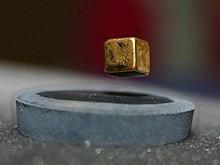Levitation (physics): Difference between revisions
No edit summary |
No edit summary |
||
| Line 3: | Line 3: | ||
'''Levitation''' (from [[Latin]] ''levis'', light) is the [[process]] by which an [[object]] is [[suspension|suspended]] against [[gravity]], in a [[stable]] [[position]], by a [[force]] without [[physical contact]]. |
'''Levitation''' (from [[Latin]] ''levis'', light) is the [[process]] by which an [[object]] is [[suspension|suspended]] against [[gravity]], in a [[stable]] [[position]], by a [[force]] without [[physical contact]]. |
||
Levitation can be achieved through [[jet]]s of [[gas]] pushing upwards against the object (as in [[air hockey]]), or pushing downwards from the object (as in [[helicopter]]s, [[VTOL]] [[aircraft]], and [[hovercraft]]). Levitation through forces that act at a distance, such as through [[magnetic force]] is also possible. |
|||
The concept of Levitation is also a part of some [[Eastern]] [[religion]]s and [[magic]]al [[belief]]s. |
|||
| ⚫ | |||
| ⚫ | |||
Objects with the right properties can be levitated without even indirect contact through the use of [[magnetic force|magnetic]] or [[electric force]]s. Technically, ([[human being]]s) are in a [[state]] of constant levitation, since their [[body|bodies]] [[exertion|exert]] a force on physical bodies and they exert one in return ([[Newton's laws|Newton's third law]]). So, their bodies never actually come into contact with another object. |
|||
Some |
Some beliefs include ideas that are [[paranormal]] ways to levitate objects. These may include [[mystical]] or [[magic]]-related methods of raising an object off the ground. Perhaps the most [[stereotypical]]ly famous example is of [[monk]]s and/or religious people that live a [[hermetic]] life levitating at will, a today-common element{{Citation needed}}, almost a [[cliche]], in [[fiction]] involving monks. It is said that the [[Christian]] [[theologian]] [[Thomas Aquinas]] was seen levitating after a mystical experience. The numerous [[story|stories]] involving religious or religion-related/-induced levitation suggest that "true" or unaided (by apparent, or, at least, [[earth]]ly [[forces]]) levitation may be a [[divine]] act or consequence of a divine [[revelation]]. |
||
"Levitation" is also used in reference to an apparent levitation. |
"Levitation" is also used in reference to an apparent levitation. |
||
Revision as of 00:16, 2 June 2006

Levitation (from Latin levis, light) is the process by which an object is suspended against gravity, in a stable position, by a force without physical contact.
Levitation can be achieved through jets of gas pushing upwards against the object (as in air hockey), or pushing downwards from the object (as in helicopters, VTOL aircraft, and hovercraft). Levitation through forces that act at a distance, such as through magnetic force is also possible.
The concept of Levitation is also a part of some Eastern religions and magical beliefs.
A sphere can be stably levitated in a stream of air without any type of control system, if conditions are right. These effects are due to Bernoulli's principle. This was merchandised as a toy, circa 1960.
Some beliefs include ideas that are paranormal ways to levitate objects. These may include mystical or magic-related methods of raising an object off the ground. Perhaps the most stereotypically famous example is of monks and/or religious people that live a hermetic life levitating at will, a today-common element[citation needed], almost a cliche, in fiction involving monks. It is said that the Christian theologian Thomas Aquinas was seen levitating after a mystical experience. The numerous stories involving religious or religion-related/-induced levitation suggest that "true" or unaided (by apparent, or, at least, earthly forces) levitation may be a divine act or consequence of a divine revelation.
"Levitation" is also used in reference to an apparent levitation.
The original use of the word was to refer to such inexplicable claims, as in wonder stories and unauthenticated reports; the use of the word to describe an actual, physical means of "making things float in the air" is a recent development.
See also
- Physical Effects
- Magnetic levitation (rail systems etc)
- Electrostatic levitation
- Magic Illusions
- Props
- Other
- Metaphysical levitation (by means not known to modern science, such as witchcraft and the occult)
- Levitation is also the name of a band.
